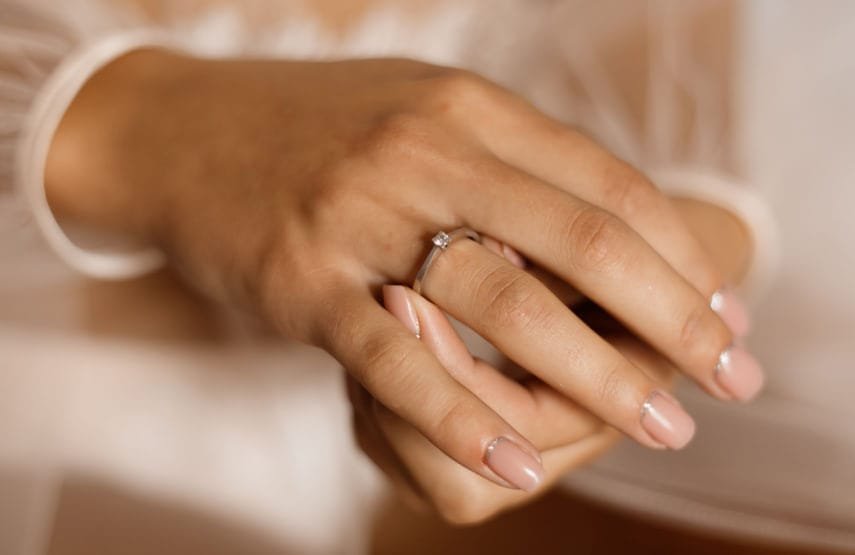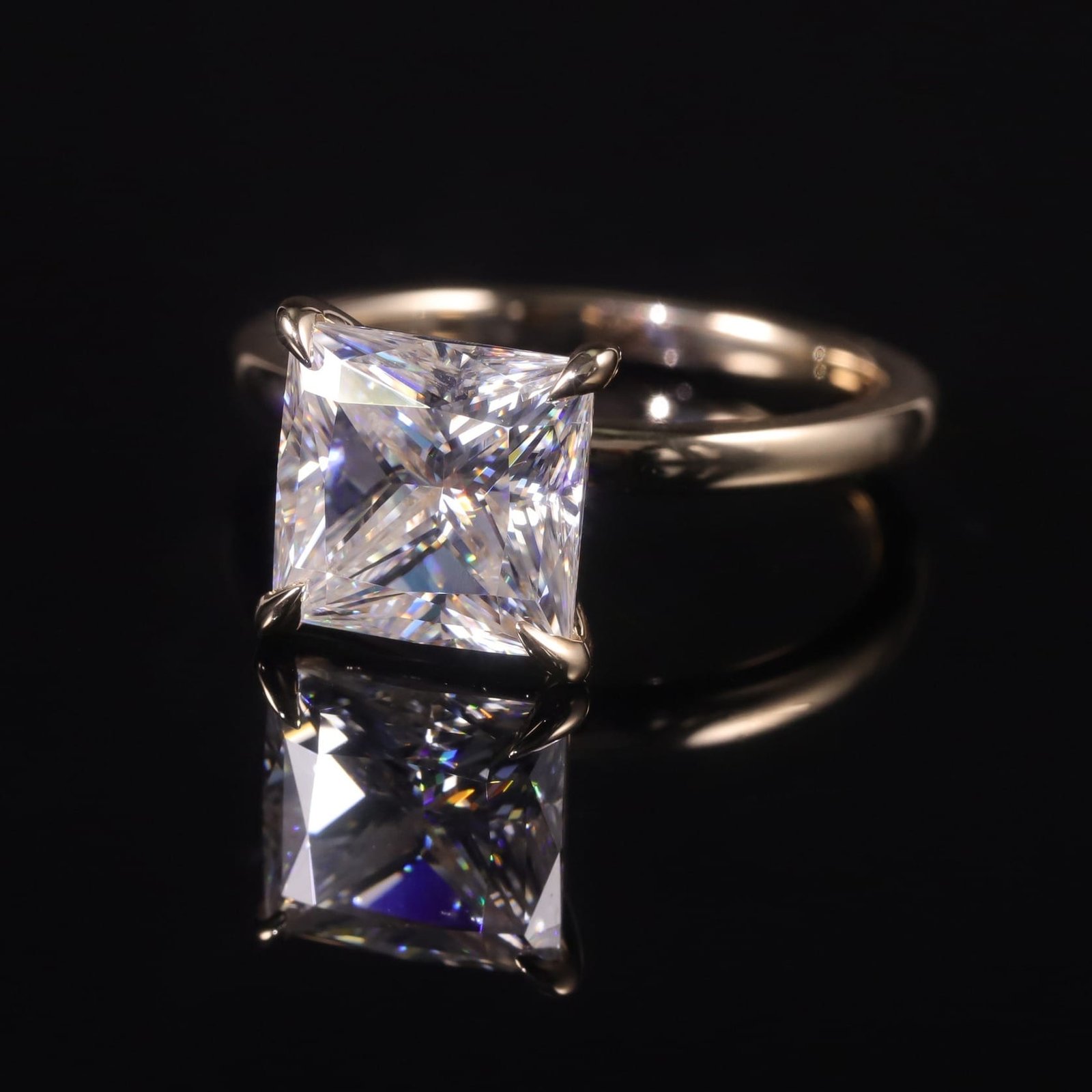
When JIEMIIYOU launched in 2017, there were only natural diamonds available for purchase. But by 2024, more than half of all engagement rings sold in the U.S. will feature lab-grown diamonds.
That goes to show how popular they are! But should you really choose a lab-grown diamond for your engagement ring? Read on to learn what lab-grown diamonds are, the pros and cons compared to natural diamonds, what to avoid, and how to find the best deals and buy them in the safest way.
What are lab-grown diamonds?
Did you know that lab-grown diamonds are different from imitations or simulants? They have all of the same properties as mined diamonds, including physical, chemical, and optical properties. The only difference between the two is the source. It’s fascinating to think that technology has advanced to the point where diamonds can be created in a lab that are virtually indistinguishable from diamonds found in nature. I mean, you can’t tell with your naked eye at all; you need special equipment to test whether it’s lab-grown or natural. The journey of these diamonds begins in a laboratory, using methods such as High Pressure High Temperature (HPHT) and Chemical Vapor Deposition (CVD) to recreate the conditions in which diamonds naturally form deep in the Earth’s mantle.
When were lab diamonds invented?
In 1954, General Electric, a company famous for manufacturing kitchen refrigerators, achieved a major milestone when it successfully created the first artificial diamond. However, these diamonds were not created for beauty, they were mainly used for industrial purposes. Industrial diamonds have a wide range of applications in lasers and abrasives. It was not until the 1970s that General Electric introduced the first gem-quality HPHT diamond to the world.
- Why are lab-grown diamonds so popular?
The lab-grown diamond market is reshaping the landscape of the jewelry industry. The sector combines advanced technology, sustainable practices, and the timeless appeal of diamonds to offer consumers an ethical and economically viable alternative to natural diamonds. - The industry has attracted the attention of both investors and consumers. Investors are attracted by its high growth potential, scope for innovation, and the opportunity to participate in an industry that is traditional but open to change. Consumers, on the other hand, are attracted by the affordable prices of these diamonds, the ethical way they are produced, the absence of any humanitarian issues, and the minimal impact on the environment.
- The jewelry market is undergoing a major shift due to the advent of lab-grown diamonds. The sector blends advanced technology, sustainable practices, and the enduring appeal of diamonds to offer a cost-effective and ethical alternative to natural diamonds.
- This shift has generated a lot of interest from both investors and consumers. Investors see huge growth potential, appreciate its innovativeness, and cherish the opportunity to participate in an industry that, while traditional, is ready for change.
- For consumers, lab-grown diamonds are an affordable and ethical alternative. These diamonds are free of the humanitarian issues common in natural diamond mining, and have a much lower impact on the environment.
Grading of Lab-Grown Diamonds

Lab-grown diamonds are graded the same way as natural diamonds, taking into account the 4Cs (carat weight, color, clarity, and cut).
While GIA does grade lab-grown diamonds, you’ll see more grading reports from IGI because they cornered the market long ago. Both grading labs are reputable, in addition to GCAL.
Average Cost of Lab-Grown Diamonds
While it does cost money to grow a lab-grown diamond, it costs less than it does to mine a natural diamond. Therefore, these savings are passed on to the consumer. Typically, a lab-grown diamond with the same specifications (4Cs) as a natural diamond costs about 1/3 to 1/4 of the price of a natural diamond.
Check out the handy chart below to see how much you can save by buying a lab-grown diamond versus a natural diamond. It’s important to note that all diamonds compared here have a Rare Carat Ideal Cut grade and do not have fluorescence.
Natural vs. Synthetic Diamond Price Comparison Chart

*Diamond prices fluctuate daily; this chart is for comparison purposes only. Prices may have changed since this chart was created on April 11, 2024
Pros and Cons of Lab-Grown Diamonds
Pros
- You can get a bigger diamond for the same budget. Lab-grown diamonds are cheaper than natural diamonds of the same quality.
- Lab-grown diamonds look exactly the same – because they are chemically, physically, and optically identical. The only difference is their origin, which cannot be known unless tested with advanced equipment.
- Lab-grown diamonds are seen as more sustainable and environmentally friendly because they do not require mining.
- Lab-grown diamonds are, by definition, conflict-free
Cons
- The resale value of lab-grown diamonds is more uncertain – so if this is important, you may want to choose natural diamonds. Natural diamonds have been around for decades and have largely held their value. You should expect your natural diamond to sell for less than the retail price, but wholesale prices have remained largely stable.
- Although lab and natural diamonds are chemically identical, the “natural” origin of the diamond may be important to some people.
Lab-Grown vs. Natural Diamonds

While lab-grown and natural diamonds look identical to the naked eye, there are certainly differences at the microscopic and molecular level. These differences are difficult to spot and often require expensive equipment for even the most experienced gemologists.
What’s Included
Due to the differences in how lab-grown diamonds are created, the types of inclusions they contain can vary. Lab-grown diamonds contain primarily metallic inclusions from the growing solution. Fun fact: Gems with lower clarity (SI2-I3) can be magnetic! Lab-grown diamonds often contain non-diamond carbon inclusions. It’s often difficult for a trained gemologist to tell the different types of inclusions apart using only a microscope or loupe, especially in higher clarity gems (VS2+).
Phosphorescence
Sometimes, when a diamond is exposed to ultraviolet light after the light source is removed, it will glow a different color (usually blue or orange). This is called phosphorescence, and it’s pretty cool! Almost all lab-grown diamonds will have some degree of phosphorescence, which is often used to differentiate between natural diamonds and lab-grown diamonds. Some lab diamonds can also have this, especially if it has been HPHT treated to produce the color, but this is less common. Phosphorescence is not currently listed on grading reports from GIA, IGI, or GCAL.
Blue Tint (Subtle Difference)
Sometimes lab-grown diamonds have a blue tint. This is due to trace amounts of the mineral boron (which is also what makes blue diamonds blue), which is sometimes used in the growing room to remove excess nitrogen (which makes diamonds appear yellow). Removing the boron is expensive and time-consuming, so growers leave it in. If the tint is present in a diamond with a color grade of G or lower, IGI lists “Light Blue” or “Blue Tint” in the additional notes (older reports). GIA does not currently list it on its reports.

If you are color sensitive, you may notice this slight blue tint. It is harder to see when viewed face-on than from the side or bottom – luckily that is how diamonds are set in rings. As you can see in the pictures, there is a slight difference when viewing the stone from the side, but not much from the top. Keep in mind that the blue color is harder to discern in person than in pictures due to background, lighting, and the camera used.
Post-Growth Treatment
Post-growth treatment may sound scary and like something to avoid, but it is actually just another step in the growth process of lab-grown diamonds. Remember, the rest of the process takes place in the lab anyway. 70% of CVD diamonds come out of the growth chamber with a noticeable brown or yellow tint, so growers will use HPHT to remove some (or all, if they are lucky) of the color. This treatment is stable and will not change the diamond over time. It can be exposed to the heat of a jeweler’s torch or steam cleaner and will not change back to its original color. Post-growth treatments are listed in the Additional Comments section of the grading reports from IGI and GIA. This is not done to scare you or to make you not consider gemstones with post-growth treatments, but simply to provide as much detailed information about the diamond as possible.











